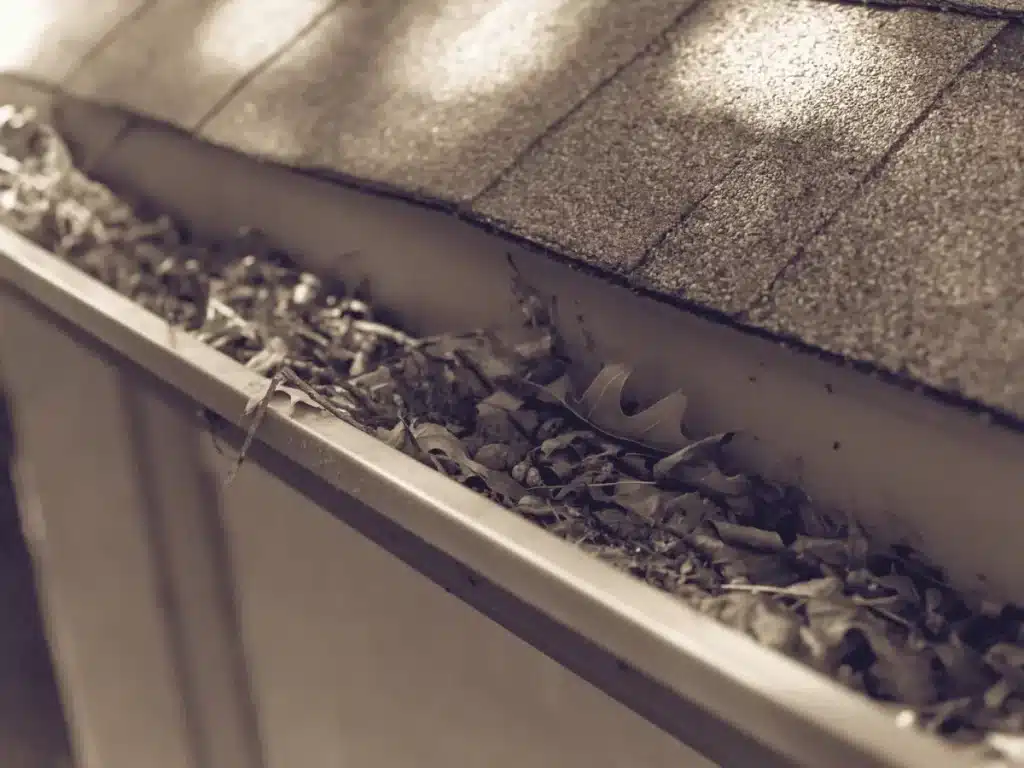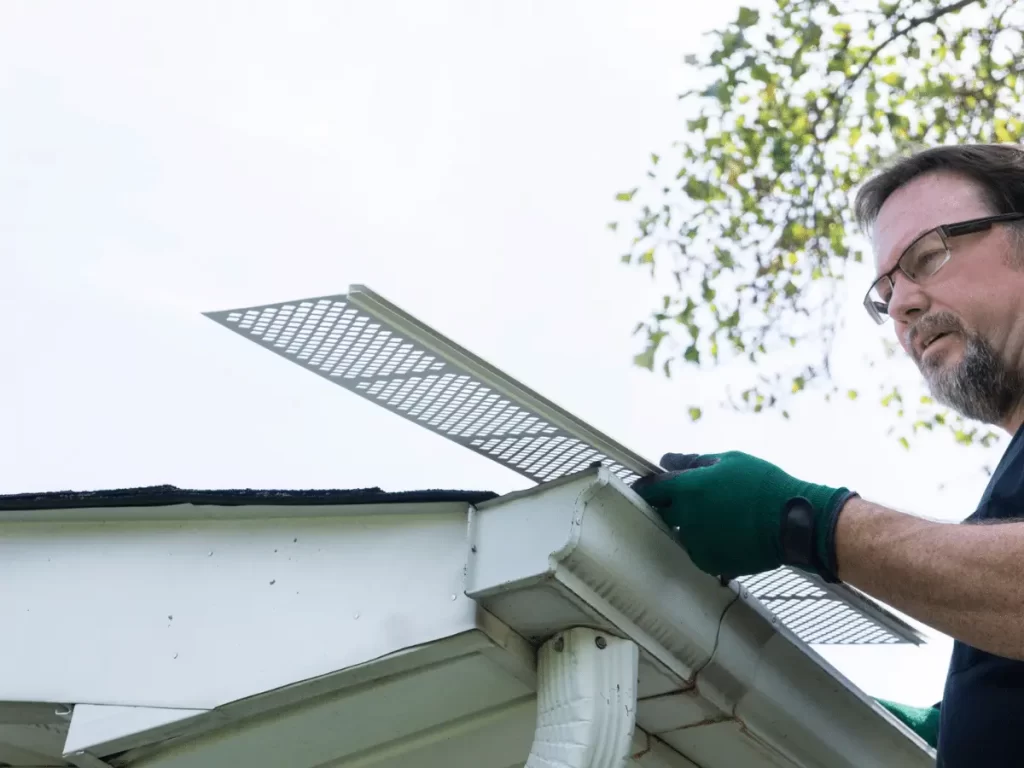Are you wondering, “How long do gutters last?” It’s a common worry for homeowners. Let’s explore the lifespan of different gutter materials and discover the best time to replace them. This guide will help keep your home’s exterior neat and protected.
Gutter Life Span by Material

Aluminum Gutters
Aluminum gutters are popular because they are cheap and easy to install. If maintained well, they can last about 20 years. Regular cleaning and checking for leaks help them reach their full lifespan. Available in many colors, they offer versatility.
Copper Gutters
Copper gutters are valued for their durability and look. They often last over 50 years, with downspouts reaching up to 100 years. Over time, they develop a green patina that protects them.
Though more costly, their long life and low maintenance make them cost-effective. So, how long do gutters last when made of copper? A significantly long time with minimal upkeep.
Vinyl Gutters
Vinyl gutters are a budget-friendly option, typically lasting around 25 years. They resist rust and corrosion but may crack in extreme cold. Available in various colors, they can fade with sun exposure. Good installation and upkeep can extend their life.
Galvanized Steel Gutters
Galvanized steel gutters have a lifespan of about 20 years. They are sturdy and good for areas with heavy rain. However, they need regular maintenance to prevent rust. Painting and sealing can help prolong their life.
How To Increase the Life Span of Gutters?
Regular care is vital to prolong the lifespan of your gutters, preventing damage and ensuring proper water flow. Here are steps to help you extend the life of your gutters:
Regular Cleaning

Twice-Yearly Cleaning
Clean gutters twice a year, in spring and fall, to remove leaves, twigs, and debris that cause clogs. Clogged gutters lead to water overflow, damaging your roof and siding. Use a scoop or gutter tool to remove debris, then flush with water to ensure they are clear.
Post-Storm Checks
After major storms, inspect gutters for debris. Strong winds can add leaves and branches, causing unexpected clogs. Check for loose fasteners or damaged sections. Prompt cleaning and repairs prevent long-term issues.
Safe Cleaning Practices

Using Proper Tools
Avoid leaning ladders directly on gutters to prevent bending. Use ladder stabilizers to keep the ladder off the gutters, ensuring your weight is not on the gutter. Wear gloves to protect your hands from sharp debris.
If you’re looking for a way to clean your gutters safely and efficiently without the need for a ladder, check out our guide on how to clean gutters from the ground without a ladder for step-by-step instructions.
Non-Abrasive Cleaners
Use non-abrasive cleaners to protect gutter material. Harsh chemicals can corrode metal or degrade vinyl gutters. Use cleaners labeled safe for gutters, with a neutral pH. Rinse well to remove any residue that could harm the gutters over time.
Preventive Measures

Install Gutter Guards
Consider gutter guards to reduce debris entry. Gutter guards act as barriers, letting water flow while blocking leaves and twigs, reducing cleaning frequency and clog risk. Options include mesh screens, foam inserts, and reverse curve systems.
Apply Sealant
Apply sealant to gutter corners and seams every five years. These areas can leak due to expansion and contraction. A high-quality sealant prevents leaks, extending the gutter’s lifespan. Ensure the gutter is clean and dry before applying the sealant.
Professional Maintenance

Hire Professionals for Repairs
Hiring pros for repairs and maintenance can extend gutter life. Professionals can identify and fix issues unnoticed during regular cleaning. They handle complex tasks like realigning sagging gutters or replacing damaged sections. Regular inspections keep gutters in top condition.
Schedule a maintenance service with us today and ensure your gutters are always performing at their best.
Seasonal Maintenance Plans
Enroll in a seasonal maintenance plan with a local service. These plans include regular cleaning, inspections, and minor repairs, offering peace of mind. This proactive approach prevents small issues from becoming major problems.
When Will You Need to Replace Your Gutters?

Knowing when to replace gutters is key to avoiding major home damage. Regular checks, especially during rainy times, can spot issues early. So, how long do gutters last before needing replacement? Here are the main signs that it’s time for new gutters:
Loose or Detached Sections
If gutter sections are loose or detached, it’s a sign of wear. This can cause water to flow incorrectly, harming your home’s base and yard. Check for loose fasteners or brackets. If tightening doesn’t fix it, consider a replacement.
Widespread Rust and Corrosion
Rust shows that metal gutters are aging. Over time, rust creates holes and weakens the structure. Look for orange or brown stains on the gutters. If rust is widespread and can’t be cleaned off, it’s time to replace the gutters to prevent leaks.
Holes, Cracks, and Leaks
Holes and cracks hinder gutters from channeling water away. Small cracks can grow, especially with weather exposure. Check for leaks during rain. Persistent leaks mean it’s time for new gutters, as patching is only a short-term fix.
Gaps Between Connections
Gaps between sections allow water to escape, leading to pooling around the base This causes erosion or flooding. Regularly check seams and joints. The gutters no longer fit well if gaps are common and need replacing.
Broken Fasteners and Sagging
Fasteners hold gutters to the roof and ensure proper drainage. Broken fasteners or nails on the ground mean gutters aren’t secure. Sagging gutters appear uneven and indicate too much weight from debris or water. Replacing them ensures correct alignment.
Mold or Water Stains on Siding
Water stains or mold on the siding indicate malfunctioning gutters. Stains below gutters suggest water is spilling over or leaking through cracks. Mold shows persistent moisture, leading to rot or damage. New gutters can prevent further harm.
Pooling Water Near Foundation
Pooling water near the base is a critical sign of failing gutters. This can lead to erosion and basement leaks. After rain, check the area around the base. If there’s standing water, the gutters aren’t directing water far enough, and need a replacement.
Rain Gutter Lifespan DIY vs. Professional Installation
Choosing between DIY and professional installation for rain gutters affects their lifespan. Here are key points to help decide:
Professional Install

Proper Fit and Seal
Gutters installed by pros usually last longer due to proper fitting and sealing. Pros ensure gutters are aligned with the roof for optimal drainage. They use top-grade sealants to prevent leaks, extending gutter life. For instance, a pro might use a weather-resistant adhesive that stops water from seeping through seams.
Greater Durability
Pros use high-quality materials not easily available to homeowners. These materials, combined with expert techniques, create a more durable gutter system. For example, pros might choose thicker aluminum or steel, which withstands harsh weather better than retail materials.
Warranty and Support
Pro installs often include warranties, covering future issues. If there’s a defect, the company fixes it at no cost. For example, a five-year workmanship warranty can save on repairs. Pros also offer maintenance services, keeping gutters in top shape year-round.
DIY Install

Cost Savings
DIY installs can save money upfront by avoiding labor costs. However, mistakes can compromise the system and reduce its lifespan.
For instance, improper slope or hanger spacing can cause pooling and sagging. Initial savings may seem good, but future repairs or replacements can outweigh the benefits.
Common Errors
DIY installs often have mistakes due to a lack of tools and expertise. Errors like incorrect measurements, poor sealing, and weak attachment can cause leaks and water damage. For example, using the wrong fastener can result in gutters pulling away from the house.
Limited Materials
Homeowners may lack access to high-quality materials used by pros. Retail-grade materials might not last as long or perform well under harsh conditions. For example, thinner aluminum or vinyl from a store may dent or warp more easily than industrial-grade materials.
FAQ
How often should you change your gutters?
Gutters usually need replacing every 20 years, depending on material and care. For instance, aluminum gutters last around two decades, while copper ones can exceed 50 years. Regular checkups and upkeep extend their life. Ignoring minor issues can cause major damage, needing early replacement.
How do I know if my gutters need to be replaced?
Replace gutters if they show loose sections, rust, holes, cracks, gaps, broken fasteners, or water damage near your home. Mold or peeling paint around the foundation can signal gutter issues.
Overflowing gutters during rain indicate clogs or poor alignment. Regular checks prevent serious home damage.
Should I replace 20 year old gutters?
Yes, gutters nearing 20 years are likely at the end of their life. Even if they look okay, hidden issues like weak seams and rust may exist. Regular upkeep can only do so much. Newer gutters often perform better due to advanced materials and tech.
Is it OK to replace gutters before roof?
Yes, replacing gutters before the roof is fine if both projects are coordinated. New gutters can prevent water damage if the roof is still good. If a roof replacement is soon, it might be cost-effective to do both together, ensuring proper alignment with the roof’s drip edge.
Do gutters increase home value?
Yes, good gutters add home value by preventing water damage. Buyers appreciate a well-maintained exterior. Proper gutters avoid costly repairs to the foundation, siding, and yard. Upgrades like seamless gutters or guards can further attract buyers.
What type of gutters lasts the longest?
Copper gutters, lasting over 50 years with care, are the most durable. They resist rust and weathering and develop a protective patina. Though pricey upfront, their long life makes them cost-effective. Vinyl and aluminum, popular but shorter-lived, last 20-30 years with upkeep.
Are gutters hard to replace?
Gutter replacement can be tough for DIYers. Professional installation is advised for longevity and performance. Incorrect installs can cause leaks, poor water flow, and home damage. Pros ensure correct, secure gutter placement. DIY might save labor costs but can lead to costly errors.

2 thoughts on “How Long Do Gutters Last & Best Time To Replace Your Gutters”
Comments are closed.